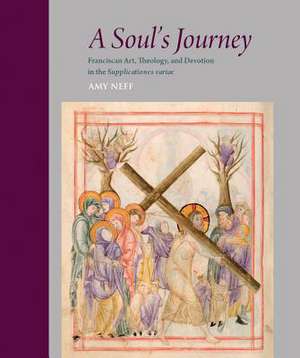A Soul's Journey Into God: Studies and Texts, cartea 210
Autor Neff, Amyen Limba Engleză Hardback
The Biblioteca Medicea Laurenziana in Florence houses an extraordinary manuscript: an anthology of devotional texts and images called the Supplicationes variae, dated 1293 and made for use in Genoa, that ends with a remarkable series of full-page illustrations. Although the Supplicationes does not include or illustrate Bonaventure's seminal text, The Soul's Journey into God, the manuscript is effectively the site for performance of a spiritual pilgrimage, for it is through the Franciscan theologian's mystical and poetic concepts that the deeper meanings of its images can be discerned.
The decorative program of the Supplicationes mirrors Bonaventure's theology of Christ as Center. Circular in composition, the introductory drawing of the Dextera dei visualizes the book's underlying thematics of the center, while at the manuscript's actual midpoint, Christ is pictured as the Man of Sorrows, who conjoins opposites, human suffering and divine glory. Yet the manuscript is also a progressive journey of ascent. In the Supplicationes, as in Bonaventure's influential book, the path to salvation begins in the world, where humankind has fallen away from God. In its Labors of the Months and marginal drolleries, the manuscript's calendar gives unusual emphasis to the hard work, ignorance, sin, and distance from God that are part of earthly existence. But there is hope: even imperfect human nature innately reaches upwards, craving relief from misery.
God answers human neediness, Bonaventure writes, with the gift of prayer, and the Supplicationes pictures this gift in an unusual miniature depicting Trinitarian grace descending on David in prayer. David becomes a model for the reader's subsequent journey through the manuscript's progressively higher levels of prayer, from the vocal prayers of psalms and offices to the contemplative prayer of reading. But it is especially remarkable that in this Franciscan book the highest level of prayer consists in contemplating images. In the sequence of tinted drawings that closes the book, text yields to image, as the reader-viewer performs a non-verbal, experiential imitatio Christi, perusing the thirty-three illustrations of Christ's life as if following the number of years of his life, and passing through Christ's humanity to salvation.
Din seria Studies and Texts
-
 Preț: 420.48 lei
Preț: 420.48 lei - 15%
 Preț: 597.39 lei
Preț: 597.39 lei -
 Preț: 317.34 lei
Preț: 317.34 lei - 15%
 Preț: 567.42 lei
Preț: 567.42 lei - 15%
 Preț: 516.44 lei
Preț: 516.44 lei -
 Preț: 325.75 lei
Preț: 325.75 lei - 15%
 Preț: 538.78 lei
Preț: 538.78 lei - 18%
 Preț: 856.42 lei
Preț: 856.42 lei - 15%
 Preț: 470.70 lei
Preț: 470.70 lei - 15%
 Preț: 557.04 lei
Preț: 557.04 lei - 15%
 Preț: 564.34 lei
Preț: 564.34 lei - 15%
 Preț: 609.40 lei
Preț: 609.40 lei - 18%
 Preț: 771.97 lei
Preț: 771.97 lei - 15%
 Preț: 691.83 lei
Preț: 691.83 lei - 15%
 Preț: 496.98 lei
Preț: 496.98 lei - 15%
 Preț: 569.21 lei
Preț: 569.21 lei - 15%
 Preț: 541.19 lei
Preț: 541.19 lei
Preț: 902.01 lei
Preț vechi: 1100.01 lei
-18% Nou
172.72€ • 177.97$ • 144.94£
